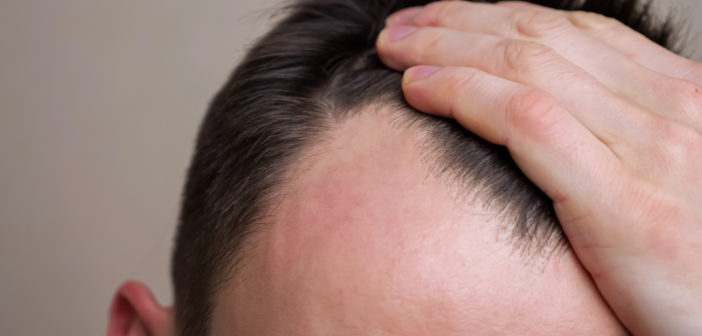A newly discovered cause of balding in aging male mice could reveal a cause of hair loss in men and women as well, reports a study from Northwestern Medicine scientists published in Nature Aging. The findings provide new insight into how hair and tissues age.

The study that shows as hair stem cells age, they lose the stickiness that keeps them lodged inside the hair follicle. As their adhesiveness wanes, the stem cells escape from their location, called the bulge, into the dermis. Outside their delicate microenvironment, they generally can’t survive.
“The result is fewer and fewer stem cells in the hair follicle to produce hair,” said lead author Rui Yi, PhD, the Paul E. Steiner Research Professor of Pathology. “This results in thinning hair and ultimately baldness during aging.”
The finding could likely apply to older men and women with thinning hair because there are many similarities between mice and humans in hair and stem cells, Yi said.
This is the first time hair follicle aging has been tracked in live animals, allowing scientists a real-time cellular view of the aging process.
Scientists also discovered two key genes responsible for enhancing adhesiveness of the stem cells. In a current study, they are trying to reinstate these genes to see if that will reverse hair loss.
It’s always life and death for hair follicles
Our hair follicle goes through cycles of life and death. During these normal cycles, a large number of stem cells stay permanently lodged in the stem cell compartment of hair follicles to keep producing hair follicle cells. In this study, scientists discovered what happens to these stem cells due to aging, resulting in thinning hair and balding.
How the study advances research
“We believe this stem cell escape mechanism has never been reported before, because nobody could track the aging process in live animals,” Yi said.
Scientists knew hair follicles become miniaturized during aging. But how it happened wasn’t clear. Many scientists thought it was due to cell death or the inability of cells to divide as they age.
“We discovered, at least in part, it is due to hair follicle stem cells migrating away from their niche,” Yi said. “Cell death also occurs during our observation. So, our discovery doesn’t dispute existing theories but provides a new mechanism.”
How the study worked
Scientists labeled hair follicle cells, including stem cells, with green fluorescent protein in live mice and used a long, wavelength laser to observe hair follicle cells during aging. They observed the same hair follicle repeatedly for many days (in one case, they observed one hair follicle for 26 days and saw the entire process of hair follicle degradation). They saw signs of unusual cell escape.
Next, they compared gene expression levels between young and old animals in follicle stem cells. They found less expression of genes responsible for adhesion in old hair follicle stem cells.
Researchers then identified a special group of genes which may regulate these cell adhesion genes. They genetically knocked out these two genes, FOXC1 and NFATC1, in mutant animals. The result: rapid progress of hair loss starting at four months. Within 12 to 16 months, these mice became completely bald. Finally, researchers used the live imaging to observe stem cell escape in these mutant mice and captured the action of stem cells migrating away from stem cell niche.
Other Northwestern authors are Chi Zhang (a visiting student); Dongmei Wang, PhD, research assistant professor of Pathology; Jingjing Wang, PhD; and Tsutomu Kume, PhD, professor of Medicine in the Division of Cardiology.
The study was supported by grants AR059697, AR066703 and AR071435 from the National Institute of Arthritis, Musculoskeletal and Skin Diseases and F99CA253738 from the National Cancer Institute of the National Institutes of Health.







